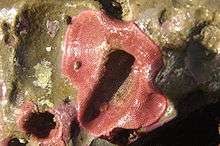Ascophora
Ascophora is an infraorder under order Cheilostomata of the Bryozoa.
| Ascophora | |
|---|---|
 | |
| Eurystomella bilabiata | |
| Scientific classification | |
| Kingdom: | Animalia |
| Clade: | Lophophorata |
| Phylum: | Bryozoa |
| Class: | Gymnolaemata |
| Order: | Cheilostomata |
| Suborder: | Ascophora Levinsen, 1909 |
| Subgroups | |
They are now considered a synonym of Flustrina. [1]
Ascophorans are distinguished from other cheilostomes in having a completely calcified wall covering their frontal surface apart from the orifice, and possessing an ascus (hence the name of the suborder). The ascus is a water-filled sac of frontal membrane opening at or near the orifice. It functions as a hydrostatic system by allowing water into the space below the inflexible frontal wall when the zooid everts its polypide (feeding tentacles) by muscles pulling the frontal membrane inwards (non-ascophorans do not need this structure as their frontal wall is not calcified).
The structure of this frontal wall is the basis of distinguishing the four major subdivisions of the Ascophora, each of which is, however, currently under suspicion of being polyphyletic and/or paraphyletic.[2] They are therefore listed here as 'unranked' groupings.
Ascophorans are exclusively marine, but very widespread geographically and ecologically. They grow on various substrates and in a variety of colony shapes.
Classification
- Suborder Ascophora
- Section Acanthostegomorpha
- Superfamily Cribrilinoidea
- Family Cribrilinidae
- Family †Lekythoglenidae
- Family Euthyroididae
- Family Polliciporidae
- Superfamily Bifaxarioidea
- Family Bifaxariidae
- Family †Platyglenidae
- Family Mixtopeltidae
- Superfamily †Scorioporoidea
- Family †Scorioporidae
- Family †Nephroporidae
- Superfamily Catenicelloidea
- Family Catenicellidae
- Family †Concatenellidae
- Family Eurystomellidae
- Family Savignyellidae
- Family Petalostegidae
- Superfamily Cribrilinoidea
- Section Hippothoomorpha
- Superfamily Hippothooidea
- Family Hippothoidae
- Family Chorizoporidae
- Family Trypostegidae
- Family Pasytheidae
- Superfamily †Dysnoetoporoidea
- Family †Dysnoetoporidae
- Superfamily Hippothooidea
- Section Umbonulomorpha
- Superfamily Arachnopusioidea
- Family Arachnopusiidae
- Family Exechonellidae
- Superfamily Adeonoidea
- Family Adeonidae
- Family Adeonellidae
- Family Inversiulidae
- Superfamily Pseudolepralioidea
- Family Pseudolepraliidae
- Superfamily Lepralielloidea
- Family Dhondtiscidae
- Family Bryocryptellidae
- Family Romancheinidae
- Family †Sfeniellidae
- Family Umbonulidae
- Family Tessaradomidae
- Family Hincksiporidae
- Family Sclerodomidae
- Family Metrarabdotosidae
- Superfamily Chlidoniopsoidea
- Family Chlidoniopsidae
- Superfamily Arachnopusioidea
- Section Lepraliomorpha
- Superfamily Smittinoidea
- Family Smittinidae
- Family Bitectiporidae
- Family Watersiporidae
- Superfamily Schizoporelloidea
- Family Schizoporellidae
- Family Stomachetosellidae
- Family Tetraplariidae
- Family †Bryobaculidae
- Family Phorioppniidae
- Family Porinidae
- Family Margarettidae
- Family Myriaporidae
- Family Hippopodinidae
- Family Pacificincolidae
- Family Hippaliosinidae
- Family †Duvergieriidae
- Family Gigantoporidae
- Family Lanceoporidae
- Family Cheiloporinidae
- Family Cryptosulidae
- Family Actisecidae
- Family Teuchoporidae
- Family Echinovadomidae
- Family Phoceanidae
- Family Mawatariidae
- Family Vicidae
- Family †Cheilhorneropsidae
- Family Microporellidae
- Family Calwelliidae
- Family Petraliidae
- Family Petraliellidae
- Family Cyclicoporidae
- Family Lacernidae
- Family Escharinidae
- Family Acoraniidae
- Family Buffonellodidae
- Family Jaculinidae
- Family Eminooeciidae
- Family Fenestrulinidae
- Superfamily Urceoliporoidea
- Family Urceoliporidae
- Family †Prostomariidae
- Superfamily Didymoselloidea
- Family Didymosellidae
- Superfamily Euthyriselloidea
- Family Euthyrisellidae
- Superfamily Siphonicytaroidea
- Family Siphonicytaridae
- Superfamily Mamilloporoidea
- Family Mamilloporidae
- Family Crepidacanthidae
- Family Cleidochasmatidae
- Family Ascosiidae
- Superfamily Celleporoidea
- Family Celleporidae
- Family Torquatellidae
- Family Hippoporidridae
- Family Phidoloporidae
- Superfamily Conescharellinoidea
- Family Conescharellinidae
- Family Batoporidae
- Family Lekythoporidae
- Family Orbituliporidae
- Family †Cuvillieridae
- Superfamily Smittinoidea
- Section Acanthostegomorpha
References
- WoRMS (2020). Ascophora. Accessed at: http://www.marinespecies.org/aphia.php?p=taxdetails&id=153674 on 2020-02-12
- Gordon, D.P. 2000. Towards a phylogeny of cheilostomes - morphological models of frontal wall/shield evolution. Proceedings of the 11th International Byozoology Association Conference: 17-37